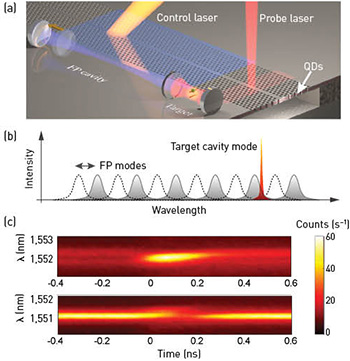 (a) Nonlocal control of atom-cavity interaction. The lattice constant along a W1 photonic crystal waveguide is modulated in different regions to define the target (red) and Fabry-Perot (FP) cavity (blue). (b) Bringing one of the FP modes in or out of the resonance of the target cavity mode produces a redistribution of the mode field and a change of Q-factor. (c) Time-resolved µPL maps made by measuring the decay curves at different wavelengths, by bringing one of the FP modes out of resonance (top) or in resonance (bottom) to the target cavity mode.
(a) Nonlocal control of atom-cavity interaction. The lattice constant along a W1 photonic crystal waveguide is modulated in different regions to define the target (red) and Fabry-Perot (FP) cavity (blue). (b) Bringing one of the FP modes in or out of the resonance of the target cavity mode produces a redistribution of the mode field and a change of Q-factor. (c) Time-resolved µPL maps made by measuring the decay curves at different wavelengths, by bringing one of the FP modes out of resonance (top) or in resonance (bottom) to the target cavity mode.
The real-time manipulation of electromagnetic fields is fundamentally important to cavity quantum electrodynamics (CQED) studies since the matter-field interaction forms the basis of CQED effects and of radiative processes used in classical and quantum photonics. In quantum information systems based on semiconductor quantum dots (QDs), the photons carrying information in the distributed quantum network have to be stored and processed within the radiative lifetime of carriers in QDs and the coherence time in the quantum node, which requires sub-nanosecond manipulation.1 For this purpose, the ultrafast control of local density of states in photonic crystals (PhCs) was theoretically proposed a decade ago.2 This proposal was based on a local perturbation of photonic band gap structure through the transient injection of free carriers, in which a simultaneous perturbation of the atomic state is inevitable and hence limits its applicability.
We have demonstrated a nonlocal control scheme based on coupled PhC cavities.3 By injecting free carriers into a Fabry-Perot (FP) cavity, FP modes are brought transiently in or out of resonance of the target cavity mode. The distribution of electromagnetic field in the coupled-cavity system is modified, resulting in the real-time control of QD-cavity interaction and the spontaneous emission rate of QDs located in the target cavity on a timescale of about 200 ps, far below the radiative lifetime. The spontaneous emission rate can be reduced or increased depending on the initial detuning, as observed in the time-resolved micro-photoluminescence (µPL) map. Further experiments have demonstrated a deviation from the usual exponential decay when the QDs are excited by a short pulse.
The temporal resolution of our nonlocal control scheme is determined by the free-carrier lifetime that can be potentially accelerated to a few ps by applying a reverse-bias to the control cavity. This opens possibilities for CQED studies, from the real-time modulation of the waveform of single-photons to the on-off switching of Rabi oscillations. As the cavity field also determines the stimulated emission rate, the same method can be used to dynamically change the Q-factor and/or the gain in microcavity lasers, leading to a new class of ultrafast Q- and gain-switching techniques for semiconductor lasers.
Researchers
C.-Y. Jin, M.Y. Swinkels, T.B. Hoang, L. Midolo, P.J. van Veldhoven and A. Fiore, COBRA Research Institute, Eindhoven University of Technology, the Netherlands
R. Johne, COBRA and the Max Planck Institute for the Physics of Complex Systems, Germany
References
1. J.I. Cirac et al. Phys. Rev. Lett. 83, 967 (1999).
2. P.M. Johnson et al. Phys. Rev. B 66, 081102 (2002).
3. C.-Y. Jin et al. Nat. Nanotechnol. 9, 886 (2014).
